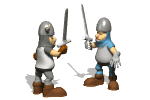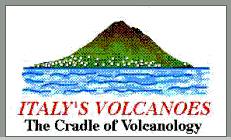
Candida Martinelli's Italophile Site

Main
Page This family-friendly site celebrates Italian culture for the enjoyment of children and
adults. Site-Overview
Inspired
by a theatrical group that presents all of Shakespeareís plays in the
time it normally takes to perform one play, here is an abridged history
of Italy in one article. These
are links to my sections on Italy's various historical eras. Click
on the logo above to go to a site that explains all you ever wanted to
know about Italy's volcanoes. The volcanoes are responsible for the
creation of much of southern Italy, as you can see from the map at the
bottom of their page. Click
on the image above of the Ancient Languages of Italy to read about the
various languages spoken on the Italian peninsula by the various tribes
living there during ancient times. The link at the bottom of their
page connects you to another online history of Italy.
Click
on the images above to visit a wonderful site, with a clickable map, all
about Magna Graecia. It is an on-line archive of not only the
history of the areas but of the coins from that era found in those sites. Click
on the text above taken from a site, mainly in Italian, but with some
pages in English, all about Magna Graecia. Click
on either piece of jewelry to visit the Italian site for the Museum of
Magna Graecia in Taranto, Italy.
To find
books about Italy's history, the prices, and what people think of them,
you can use this Amazon.com search tool. Just enter 'Books' in the
'Search' field, and 'Italian history' in the 'Keywords' field.
Then click on the 'Go' button to see the list. Looking
back 25 million years, Europe was barely in existence.
Two-thirds of what we now call Europe was under water.
And Italy was little more than a few volcanic protrusions in the
Mediterranean Sea. Looking
back 10 million years, when precursors of homo sapiens lived in
Africa, Europe was only slightly larger but entering an ice age that
would cover itís northern half for nearly one million years, the
remains of which still cover the Alps. Italy
protruded from the Mediterranean along itís backbone, the Apennine
mountain range, and was surrounded by several islands, some of which
would remain islands, others that would join up with the main parts of
the growing peninsula. With
the Alps growing in the North, the Apennines rising along itís center,
and the volcanic islands growing all around her, modern Italy took
shape. It is a shape and
construction that explains todayís diverse and volatile landscape. Italy
is divided geographically north to south and east to west. Volcanoes still erupt, earthquakes still rumble, landslides
and flooding still reshape the landscape, and sharp differences in
weather separate the agriculture and even culture around the country,
especially from north to south. Starting
from about 8000 B.C., Europe and Italy had taken on their present
shape, and the weather had become milder.
As a result: Sturdy
hunter-gatherers either made way for farmers, or became farmers. Virgin
forests were cut down over time for fuel, construction materials,
and to clear land for agriculture. And
native big game was hunted until todayís near extinction to feed
the growing population. Cities
grew to house the stored foodstuffs and to protect the settled clans
and tribes from raiding parties from less settled clans and tribes. It
is during this time that Italy became populated with many of the people
who would give the rich variety of culture, traditions, language,
character and physicality to present day Italians. Each
tribe had a reputation. Some
were known for their fighting skills, others for their trading and
seafaring, some for the beauty of their women.
Their territory shifted with each struggle, each battle, each new
agreement reached between the ever more integrating groups. Intermarriage
and joining together for strength against outsiders would bring
greater unity, but it would not be until the Romans expanded from
western-central Italy to create an empire that all of modern Italy would
be united. The
expanding Greek civilization starting from about 3000 B.C.,
finally colonized southern Italy around 800 B.C..
The local tribes were either absorbed into the colonies, pushed
aside, or destroyed. All
of Sicily and southern Italy up to just below Rome had Greek outposts. The
Greek colonies were like most ancient colonies, set up to strip the land
of the natural resources. They
cut down trees to make fleets of boats, drowned pleasurably in Italyís
abundant wines, and planted olive trees and grain to feed their soldiers
and citizens all over their empire. At
this same time, the Greek-originating Etruscans make their mark
on Italy. While their
territory is usually defined as covering central Italy down to Rome,
their influence was much wider. Like
the Phoenicians before them, they traded all around the coastal regions
of the Mediterranean. They
spread their famous bronzes along with goods from the entire basin. One
thing they did not manage to spread was their egalitarian values and
respect for women. In fact, the Romans and other macho tribes ridiculed Etruscan
respect for women, as macho societies still ridicule today modern
egalitarian societies. Next section: Ancient History
References
for all the articles are various including the links on these pages and Monarch Notes and
Study Guidesí 'World History', and 'Western Civilization'; and
De Agostiniís Atlante Storico Mondiale, and Grande Atlante
DíItalia.

Italian
History
![]()

The
Natural History of Italy
Pre-History